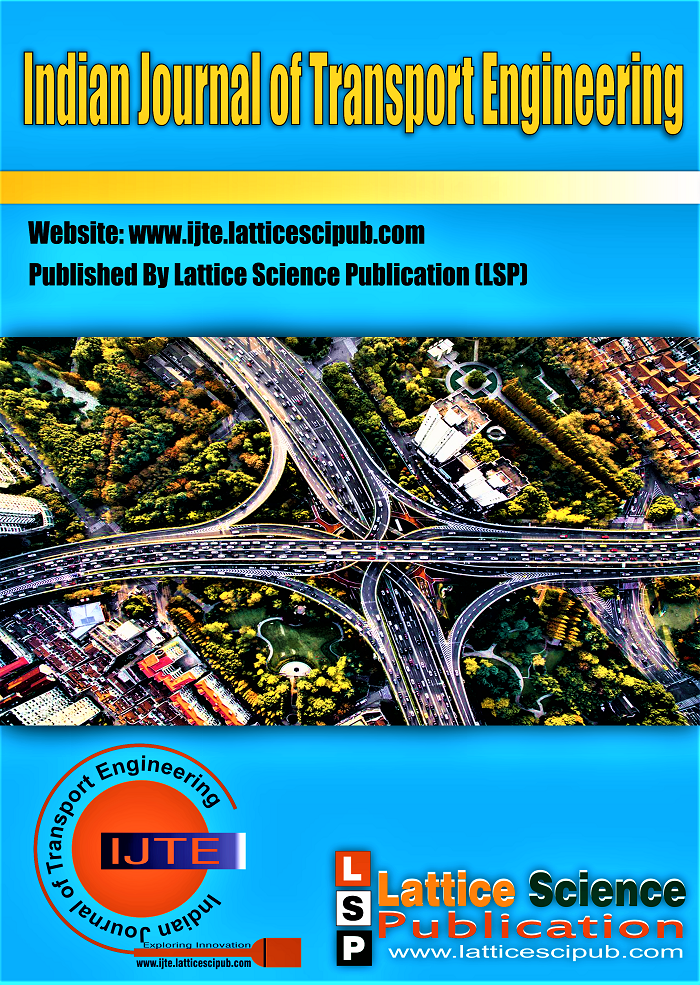Road Safety Perception of Different Types of Drivers in Egypt
Main Article Content
Abstract
The present research examined the variation in driving behaviors among drivers of different types of vehicles in Egypt. Three categories of drivers have been investigated: private car drivers, microbus drivers, and motorcyclists. A customized version of the Manchester Driver Behavior Questionnaire (DBQ) was developed for the data collection process. An exploratory factor analysis (EFA) was applied to the questionnaire data to determine the underlying factors within the set of behavioral items. The EFA has helped identify three robust factors: Errors, Positive Behaviors, and Violations, respectively, within the responses of drivers.Multiple regression analyses were carried out to establish which socio-demographic variables are the best predictors of each of the three deduced factors. One-way ANOVA tests were then conducted to analyze the differences among the three drivers categories in terms of the three EFA factors as well as the history of crashes and violations. It was found that microbus drivers committed a significantly higher number of traffic violations than both motorcyclists and private car drivers. Also, private car drivers were involved in a fewer number of crashes and had more positive driving behavior compared to microbus drivers. The research findings would aid in targeting the high-risk drivers in future road safety educational campaigns and training courses.
Downloads
Article Details

This work is licensed under a Creative Commons Attribution-NonCommercial-NoDerivatives 4.0 International License.
How to Cite
References
Ederer DJ, Rodgers MO, Hunter MP, Watkins KE. Case Study using Probe Vehicle Speeds to Assess Roadway Safety in Georgia. Transp Res Rec [Internet]. 2020 Sep 10;2674(11):554–62. Available from: https://doi.org/10.1177/0361198120948858 [CrossRef]
Ambros J, Viktorová L, Turek R, Šucha M. How do we perceive traffic risk ? HOW DO WE PERCEIVE TRAFFIC RISK ? 2016;(November).
de Winter JCF, Dodou D. The Driver Behaviour Questionnaire as a predictor of accidents: A meta-analysis. J Safety Res [Internet]. 2010;41(6):463–70. Available from: https://www.sciencedirect.com/science/article/pii/S0022437510001131 [CrossRef]
Tsala SAZ, Ayissi MZ, Azeh G, Noah PA, Ebanda FB, Ohandja LMA. An in-depth analysis of the causes of road accidents in developing countries: case study of Douala-Dschang Highway in Cameroon. J Transp Technol (Irvine, Calif) [Internet]. 2021;11(3):455–70. Available from: http://dx.doi.org/10.4236/jtts.2021.113030 [CrossRef]
CAPMAS. The Annual Bulletin of Car & Train Accidents 2019. (Central Agency for Public Mobilization and Statistics, Egypt.) [Internet]. 2020. Available from: https://censusinfo.capmas.gov.eg
REASON J, MANSTEAD A, STRADLING S, BAXTER J, CAMPBELL K. Errors and violations on the roads: a real distinction? Ergonomics [Internet]. 1990 Oct 1;33(10–11):1315–32. Available from: https://doi.org/10.1080/00140139008925335 [CrossRef]
Shao H, Yin J, Yu W hao, Wang Q ling. Aberrant Driving Behaviours on Risk Involvement among Drivers in China. J Adv Transp. 2020 Jun 29;2020:1–8. [CrossRef]
Mekonnen T, Tesfaye Y, Moges H, Berhe R. Factors associated with risky driving behaviors for road traffic crashes among professional car drivers in Bahirdar city, northwest Ethiopia, 2016: A cross-sectional study. Environ Health Prev Med. 2019 Dec 1;24. [CrossRef]
Bener A, Yildirim E, Bolat E, Özkan T, Lajunen T. The Driver Behaviour Questionnaire as an Accident Predictor in Cross-cultural Countries in Qatar and Turkey: Global Public Health Problem. Br J Med Med Res. 2016 Jan 10;15:1–9. [CrossRef]
Sucha M, Sramkova L, Risser R. The Manchester driver behaviour questionnaire: self-reports of aberrant behaviour among Czech drivers. Eur Transp Res Rev. 2014 Dec 1;6. CrossRef
Bener A, Özkan T, Lajunen T. The Driver Behaviour Questionnaire in Arab Gulf countries: Qatar and United Arab Emirates. Accid Anal Prev. 2008 Aug 1;40:1411–7. [CrossRef]
Bandyopadhyaya V, Bandyopadhyaya R, Barman S. Understanding Key Behavioral Factors Affecting Road Traffic Citation and Crash Involvement of Professional Bus and Passenger Van Drivers Using Modified Driver Behavior Questionnaire – An Indian Perspective. Int J Occup Saf Ergon JOSE. 2022 Oct 27; [CrossRef]
Kalhori RP, Ziapour A. A Survey of Interurban Taxi Drivers ’ driving Behaviors across. 2017;(April). [CrossRef]
Sullman M, Meadows M, Pajo K. Aberrant Driving Behaviours Amongst New Zealand Truck Drivers. Transp Res Part F Traffic Psychol Behav. 2002 Sep 1;5:217–32. [CrossRef]
CAPMAS. Bulletin of Licensed Vehicles Statistics in 31/12/2021. (Central Agency for Public Mobilization and Statistics, Egypt.) [Internet]. 2022. Available from: https://www.capmas.gov.eg/Pages/Publications.aspx?page_id=5104&YearID=23468
Ahmad H, Halim H. Determining Sample Size for Research Activities: The Case of Organizational Research. Bus Rev [Internet]. 2017;2(1):20–34. Available from: https://sbr.journals.unisel.edu.my/ojs/index.php/sbr/article/view/12/20
Bartlett JE, Kotrlik J, Higgins C. Organizational Research: Determining Appropriate Sample Size in Survey Research. Inf Technol Learn Perform J. 2001 Jan 1;19.
Naseer M, Ashfaq M, Hassan S, Abbas A, Razzaq A, Mehdi M, et al. Critical Issues at the Upstream Level in Sustainable Supply Chain Management of Agri-Food Industries: Evidence from Pakistan’s Citrus Industry. Sustainability. 2019 Mar 3;11:1–19. [CrossRef]
Renault B, Agumba J, Ansary N. An exploratory factor analysis of risk management practices: A study among small and medium contractors in Gauteng. Acta Structilia [Internet]. 2018;25:1–39. Available from: http://www.scielo.org.za/scielo.php?script=sci_arttext&pid=S2415-04872018000100001&nrm=iso [CrossRef]
Ursachi G, Horodnic IA, Zait A. How Reliable are Measurement Scales? External Factors with Indirect Influence on Reliability Estimators. Procedia Econ Financ [Internet]. 2015;20:679–86. Available from: https://www.sciencedirect.com/science/article/pii/S2212567115001239 [CrossRef]





